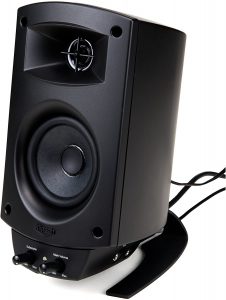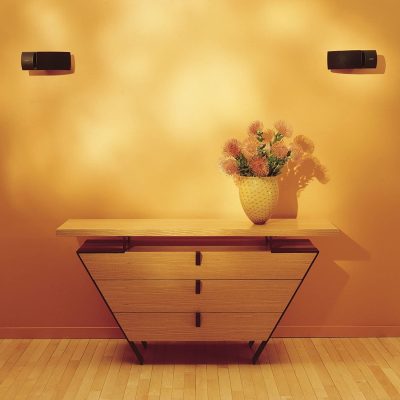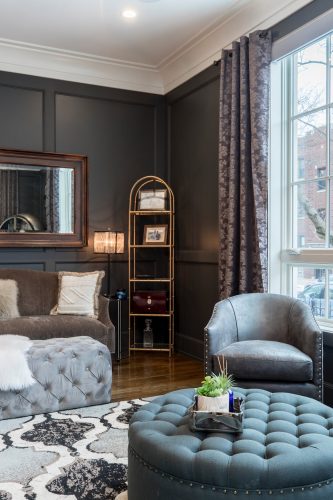
A good surround sound system comes with a lot of wires. There are many ways to hide speaker wires, but you should be careful as some might damage the cables or even your house. Hence, our sound engineers did the legwork for you and identified the best ways to hide speaker wire.
How to Hide Speaker Wires
When planning the room’s layout where you place the sound system, speaker wires are the least considered. However, once everything is in place, installing these cables will be the problem. You will be left with many if you have a fully carpeted room with your cables lying around, creating a tripping hazard for your family.

There are a lot of ways to hide the wires from plain sight. You can use cable organizers, molding, even conceal them with paint, or just go wireless. The choice depends on the floor, wall, and decor where you’ll conceal these speaker cables.
Before you start, you need to prepare the following tools:
- Hammer
- Scissors
- Staple gun
- Stud finder
- Utility knife
- Bubble level
- Screwdriver
- Wire strippers
- Tape measure
Remember to unplug all electronics first to prevent any electrocution hazards. Now, here are the ways suggested by our engineers on how to hide cables in your home theater successfully.
Using The Objects in Your Space
Using objects in your room is the easiest and cheapest way to hide wires. So, look around first for available objects that you can use to hide cable wirings.
Room Decor
Most rooms have decors big enough to be used in hiding wires. You can use your plant decors to hide your wires from plain sight. You can use an adhesive backing to secure these cables at the back of the pots.

You can also utilize furniture like cabinets and TV or speaker stands. The regular speaker cable and the surround sound speaker wire can be hooked at the back of this furniture.
However, these ways will not wholly conceal the wires. There will be parts that are still an eyesore, even a tripping hazard.
Rugs
Aside from the ones mentioned above, our experts also suggest using throw rugs to cover these annoying wires. This is an aesthetic way to cover them without messing up the design of the room.

However, as these are small items, they cannot completely cover the entirety of the wires. Also, be careful when vacuuming in order not to damage the cables. You can carefully pull the throw rugs making sure that the wires are not tugged with them.
On Carpeted Floor
Hide Underneath Carpet
Sometimes, speaker cables need to go across your floor. The best solution is to run these wires under the carpet. It will provide a more extensive cover-up on these wires, but some parts will still be visible.
If you have a fully carpeted room, you can tuck the wires underneath the carpet and the baseboard. Try to push wires between the carpet and the baseboard using your fingers first to see if it is possible.
If the mentioned trick is hard, use a slim screwdriver to push the wires in between them. Remember to do this carefully to avoid damaging the speaker wire while pushing. Do this until the wire is no longer visible.

The area below the carpet, between the tack strip and the wall, provides an excellent place to hide these cables. Hiding the speaker wire this way gives a clean and sleek look to the entire room.
On Hardwood Floor
Hardwood floors are still the choice of people when designing their homes as it provides a warm ambiance. However, the appearance of these speaker cables lessens the aesthetic effects of the hardwood flooring.
Hiding speaker wire on flooring like this can be tricky, so you need to use concealers like corner duct raceways or wire tapes.
Raceway
A cable raceway is a cheap way to hide unsightly wires that run across the floor from your surround speakers. They can also conceal wirings that run from the ceiling speakers towards the floor.

Corner ducts are very useful as they can accommodate almost any type of cable and power cord. Most raceways come in a three-sided design so that you can attach them to the floor corners. The kit also includes tee reducers.
The two edges come with a pre-applied adhesive backing. The cables are placed inside these two areas, and then the third side is used to cover them. The third one can snap on the cover, so it is straightforward to install. To finish it up, you can also paint over the ducts.
As raceways have strong adhesives, you may need to use a pry bar in disassembling them.
Wire Tape
A flat speaker wire tape offers a permanent wire installation that is completely invisible. They also provide a non-invasive viable option as you don’t need to cut a hole inside walls.

This type of tape looks a lot like packaging tape as it is also rolled. Since the regular speaker wiring and cable are flexible, the tape can cover it even in the corners. If you peel it, the industrial-strength adhesive side can stick to any surface.
If your surround speakers come in flat wires, then they are either with two or four conductors. Flat wire terminal blocks are also needed for these. One side of the block is attached to the flat copper wiring, while the other goes to the speaker cable.
Our experts suggest making sure you are installing your wires on a flat surface and carefully measure the cables. After that, carefully attach the tape according to the product’s instructions. To finish the job, you can paint the tape according to the color of your walls. This will also give the illusion of having wireless sound systems.
On the Wall
Some wires need to run across a wall, especially if your speakers are mounted on the wall. There are several ways to conceal wires to avoid your wall’s unsightly appearance.
Conceal With Paint
To camouflage wires that run in the walls using paint, you’ll need a staple, staple wires, and zip ties. Identify where the cables will run across the wall by placing the ties on your desired path. Staple these ties in the wall, then attach the cables to these wires.

The ties are stapled to the wall to prevent damage to the speaker cables to prevent impairing sound quality produced by the speakers. Remember to apply a thin layer of a paint seal before putting the paint that will camouflage your wires to the color of the wall.
This method is a semi-permanent method that is advantageous if you need to transfer the sound system into another room.
Panel Molding
Another way to hide your speaker cables is by using panel moldings. These are decorative types of moldings that are usually used to trim a raised panel in the wall. They also provide depth and aesthetics into the room.
Panel molding is also used to emphasize furniture like cabinets, so you can use this to hide your cables. You need the help of another person in installing wires using this molding. Your assistant needs to hold these cables while the molding is attached to the wall.
Another very similar to this is the chair rail molding. This was initially used to prevent damage to the walls due to consistent bumping from chairs. You can also hide the wires using this type of molding as cables are very flexible and can follow the outline of the mold.
Using the chair rail molding is an effective way to hide the different wiring from speakers.
Crown Molding
A crown molding is placed at the corners of the room where the ceiling meets the wall and provides an aesthetic effect to the room. There are several types of this, but the most cost-effective is foam crown molding.

As they come in 6-foot-6 lengths, you may need to cut and combine the moldings. The cables of your speakers can go underneath these moldings to be hidden from plain sight.
Wire Tape
Wire tapes can also be used for flat wires that run across the walls. They provide a way to effectively attach the cables to the walls and make them look flat. Also, they give a seamless method of hiding them from plain sight.
Sometimes, the only way to hide your speaker wire is to drill inside walls. For this type of method, you need to ask a professional installer for advice not to cause unnecessary damage to your room.
When working on a narrow space along the inside of walls, our experts suggest using fish tape to make the process easier. Fish tapes allow you to pull a speaker wire carefully along a narrow space.

Using fish tape will allow your surround sound cables to traverse across the wall safely.
On Baseboard
There are also instances where cable wiring needs to run across the baseboard. This method provides a way to hide the cable and minimize damage to the walls.
Cable Clips
If you don’t mind seeing the wire running across your baseboard and you just want to organize them, then cable clips will do this for you.
Cable clips are designed to secure a wire in a fixed location. They can only accommodate one wire at a time, and you may need a lot, especially when dealing with many cables. These clips prevent the wire from becoming a hazard as it is fixed on the baseboard.
Base Molding
Another very similar to the crown molding is the base moldings. However, instead of placing the molding where the wall and the ceiling meet, this is placed where the walls and the floor meet.

You need to run the wire on edge when doing this, where the wall and floor meet. Then place the moldings that will cover the wire. It is recommended to start from the first stud to have a more organized process.
If you have a preinstalled molding, remove it first, run the wire on edge, then reinstall them again following the above-mentioned method.
Other Methods
Light Strips
You can also conceal the wire using LED light strips. These strips usually run along the edge where the walls and ceiling meet so you can connect the two to conceal the wire.
Cable Organizers
Cable organizers are meant just to organize the cables, not hide them. The usual cable organizers involve just rolling them and tying the cables around. This prevents the cables from running across the floors and posing a hazard to the people in the house.
FAQ
How can I hide speaker wires without cutting a wall?
You can hide speaker wires without cutting a wall in several ways. The most common ways include crown and panel moldings, light strips, wire tapes, and duct raceways.
How do you hide speaker wire in drywall?
To hide speaker wire in drywall [1], you can install crown molding, panel molding, or base molding. Our experts also suggest wire tapes. Cutting through it is not advisable as the damage may become very extensive.
Can you run speaker wire under the carpet?
Yes, you can run speaker wire under a carpet. There is a space in between the baseboard and the carpet when the wire can go. This will provide an almost invisible way to hide the wire and prevent it from becoming a hazard.
Conclusion
Cable wires can be very unsightly and can pose a hazard. Going wireless is the best option but can be very expensive. Our experts suggest the following tips and tricks on how to hide speaker wire. It includes the use of moldings, wire tapes, duct raceways, and even light strips. They are proven ways of dealing with annoying cable wires in your sound system, as well.
The post How to Hide Speaker Wires in Your Home Theater — Must-Know Tips & Tricks appeared first on The Product Analyst.
from The Product Analyst https://theproductanalyst.com/how-to-hide-speaker-wire/
No comments:
Post a Comment